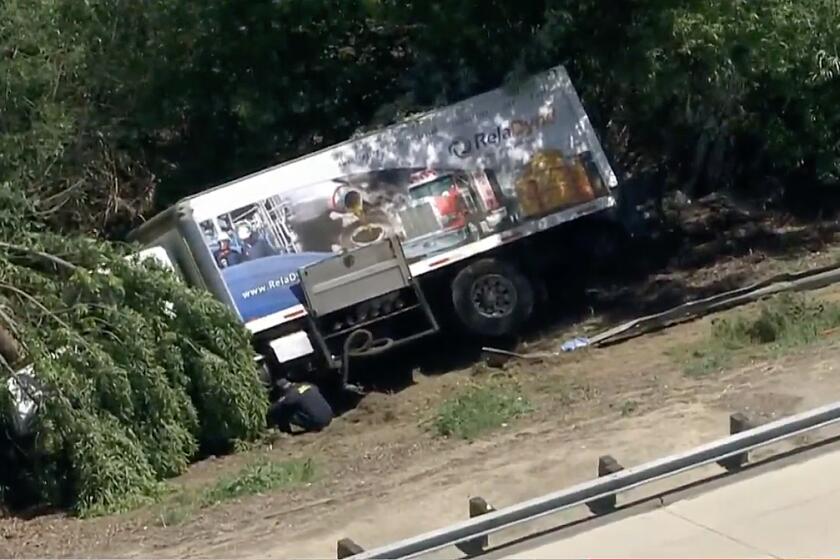Epidemic of Valley Fever Ravaging Kern County : Public health: The disease has exploded tenfold since summer of 1991. Five other counties are also affected.
For the past 16 months, a strange dust-borne disease endemic to the American Southwest has blown rampant through Kern County, infecting more than 4,000 people and killing 34, according to state and local health officials.
In what may be California’s least-known epidemic, the incidence of valley fever here has exploded tenfold since the summer of 1991 and shows no signs of flagging.
“The numbers are astounding,” said Ronald Talbot, director of the Kern County health department lab. “Any other disease with this abnormal number of infections and deaths would be grabbing national attention.”
While Kern County is the hotbed of valley fever, accounting for two-thirds of the cases and deaths statewide, the disease is also afflicting record numbers in Los Angeles, Ventura, Santa Barbara, Tulare and San Luis Obispo counties.
Health officials say that in this siege at least 6,000 people statewide have been infected with the fungus found in the arid soils of Central and Southern California, Arizona, New Mexico and Texas. About 50 Californians have died since August, 1991. A typical year sees 441 cases and six deaths statewide.
Most who take ill suffer from flu-like symptoms. But for some, the disease spreads beyond the lungs and can lead to a deadly form of meningitis. A pregnant woman dying of valley fever in Woodland Hills was kept alive on a ventilator until doctors could deliver her baby. A resident at UC Davis Veterinary Hospital succumbed after spores became airborne during an autopsy on a horse that carried valley fever.
“There have been epidemics of valley fever in the past, most recently 1978, but none that comes close to these numbers,” said Dr. Demosthenes Pappagianis, a UC Davis medical professor who has tracked the disease for 41 years.
The fungus that causes valley fever is known by the name Coccidioides immitis-- or cocci (pronounced “coxy”) for short. Experts believe half of the San Joaquin Valley’s longtime residents have inhaled cocci spores in their lifetime--many during childhood, when symptoms are mild.
Of those exposed to the spores, 30% become so ill that they call a doctor. But the disease is diagnosed in only a small percentage of them, and it is that smaller figure that gets reported to local and state health agencies.
“Only 10% of those exposed require medication and most of them get well,” said Dr. Hans Einstein, a Bakersfield physician and an authority on noted cocci . “But for some, the disease spreads beyond the lungs and attacks the skin, bones and brain. That’s when it’s nasty. That’s when it can become a killer.”
Several factors may be behind the big numbers here. Six years of drought have baked the San Joaquin Valley soil to a chalky dust easily scattered by winds that blow from late summer through winter. Much of last year’s rain came in spring--too little to offset drought but right on time to send the spores abloom.
Also, the growth boom transforming this region acts like a big spade, working the fungus to the surface where it can become airborne. With the new houses and shopping centers has come a surge of new residents who lack the immunity afforded by exposure to the fungus. They are easy targets.
It is no mystery why transplants from other regions, and people who work closely with the soil--construction and oil workers, land graders, farm workers and college students on archeological digs--rank among the groups most afflicted. But what doctors have never been able to figure out is why the worst manifestation of the disease--called disseminated cocci-- strikes certain racial groups in particular.
“One in four Filipinos or Malaysians who inhale the spores will develop serious complications,” said Dr. Royce Johnson, chief of infectious disease at Kern Medical Center. “Latinos and African-Americans and Native Americans are also at a much higher risk for disseminated cocci. “
The cruel irony here, in the agricultural heartland, is that the soil that sustains so many has turned into a stalker.
In the past three months alone, nearly 2,000 cases of valley fever have been diagnosed in Kern County residents. This is as many cases as were diagnosed in the entire state last year, which was a record year. About 800 blood tests for cocci are performed in Bakersfield each week. This year, more Kern County residents have died of valley fever than of AIDS.
“Valley fever is not a communicable disease so there is very little we can do except advise people to stay out of the dust,” said county lab director Talbot. “And staying out of the dust is not an easy thing to do in Bakersfield.”
To handle the cases, the second floor of the Kern County Hospital has been transformed into a cocci clinic. Doctors, nurses, physician assistants and medical students hop from room to room, X-ray to X-ray, spinal tap to spinal tap.
Antonio Munoz, 29, who drives a tractor in grape fields and orange groves, said he began feeling light-headed a few months ago and could not eat. For several weeks, he had a terrible cough, fevers and sweats. He lost 25 pounds before seeing a doctor. By the time valley fever was diagnosed, the fungus had spread from his lungs to the knee, jaw and second rib bones.
His body is pocked with lesions where cocci has surfaced. Doctors say if the anti-fungal medication given to patients with disseminated cocci proves ineffective, the disease must be scraped out of each infected bone area or it could spread to the brain.
“I’ve never been to a doctor in my life,” said Munoz, who left his native Mexico in 1985. “I’ve heard of other farm workers getting this but they never had the sores.
“We call it the fiebre del valle (fever of the valley).”
Joann Draper Chaney, 31, is African-American and pregnant--two factors that put her at high risk of developing the severest form of valley fever. Chaney said the worst part of having the disease is the routine spinal taps that give her a pounding, five-day headache, and the thrice-weekly injections of amphotericin B, a potent and potentially toxic anti-fungal medication. Patients call it “Ampho the Terrible.”
“It’s four hours of drip-drip IV treatment,” she said. “When you finish, you’ve got a bad headache, rash and the worst kind of shakes.”
Mei Yi, 30, had lived in America only three months when she contracted fungal meningitis from valley fever, according to her husband, Won Yi. Shortly after their Korean families arranged a July wedding in Bakersfield, Mei began suffering severe headaches and muscle pain.
The husband, a grocer, chalked it up to the strain of juggling a new country and marriage. But Mei never got better. She takes an oral medication and must submit to painful blood and spinal fluid tests to monitor the disease.
“Before this epidemic, I knew all the cases personally,” said Johnson, of Kern Medical Center. “I knew their names. I knew their spouses. I knew where they lived. I even knew their lab values.
“I was seeing three cases of meningitis a year then. I’m going to see three new ones this afternoon.”
More to Read
Start your day right
Sign up for Essential California for news, features and recommendations from the L.A. Times and beyond in your inbox six days a week.
You may occasionally receive promotional content from the Los Angeles Times.






